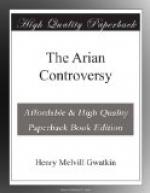Julian could not but see that Athanasius was master in Egypt. He may not have cared about the council, but the baptism of some heathen ladies at Alexandria roused his fiercest anger. He broke his rule of contemptuous toleration, and ‘the detestable Athanasius’ was an exile again before the summer was over. But his work remained. The leniency of the council was a great success, notwithstanding the calamity at Antioch. It gave offence, indeed, to zealots like Lucifer, and may have admitted more than one unworthy Arianizer. Yet its wisdom is evident. First one bishop, then another accepted the Nicene faith. Friendly Semiarians came in like Cyril of Jerusalem, old conservatives followed like Dianius of the Cappadocian Caesarea, and at last the arch-heretic Acacius himself gave in his signature. Even the creeds of the churches were remodelled in a Nicene interest, as at Jerusalem and Antioch, in Cappadocia and Mesopotamia.
[Sidenote: The Arians under Julian.]
Nor were the other parties idle. The Homoean coalition was even more unstable than the Eusebian. Already before the death of Constantius there had been quarrels over the appointment of Meletius by one section of the party, of Eunomius by another. The deposition of Aetius was another bone of contention. Hence the coalition broke up of itself as soon as men were free to act. Acacius and his friends drew nearer to Meletius, while Eudoxius and Euzoius talked of annulling the condemnation of the Anomoean bishops at Constantinople. The Semiarians were busy too. Guided by Macedonius and Eleusius, the ejected bishops of Constantinople and Cyzicus, they gradually took up a middle position between Nicenes and Anomoeans, confessing the Lord’s deity with the one, and denying that of the Holy Spirit with the other. Like true Legitimists, who had learned nothing and forgotten nothing, they were satisfied to confirm the Seleucian decisions and re-issue their old Lucianic creed. Had they ceased to care for the Nicene alliance, or did they fancy the world had stood still since the Council of the Dedication?
[Sidenote: Julian’s campaign in Persia (Mar. 5 to June 26, 363).]
Meanwhile the Persian war demanded Julian’s attention. An emperor so full of heathen enthusiasm was not likely to forego the dreams of conquest which had brought so many of his predecessors on the path of glory in the East. His own part of the campaign was a splendid success. But when he had fought his way through the desert to the Tigris, he looked in vain for succours from the north. The Christians of Armenia would not fight for the apostate Emperor. Julian was obliged to retreat on Nisibis through a wasted country, and with the Persian cavalry hovering round. The campaign would have been at best a brilliant failure, but it was only converted into absolute disaster by the chance arrow (June 26, 363) which cut short his busy life. After all, he was only in his thirty-second year.




